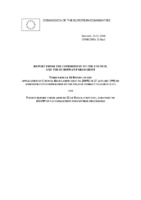| dc.description.abstract | This report describes the functioning of administrative cooperation and the structure ofthe underlying control arrangements.The transitional VAT arrangements have been in place for more than 6 years. During thisperiod, one would have expected that the implementing problems should have been solvedand that the system should be running smoothly. However, this does not appear to be thecase. The 6 years appear to have given the fraudsters time to appreciate the possibilitiesoffered by the transitional VAT arrangements to make money, while, generally speaking,Member States have not met the challenge posed by fraud.The transitional VAT system is designed so that intra-community supplies of goods areexempted from tax in the Member State of origin of the goods and instead taxation takesplace in the Member State of destination. In addition to this “normal” system, severalcomplex special schemes have been set up in areas where Member States still wanted tomaintain additional control over taxation. The exemption mechanism makes the VATsystem prone to fraud as goods can circulate tax-free and therefore it is necessary that theCommunity instruments for administrative cooperation together with national controlsystems are used to their fullest extent.The examination by the Commission of Member States’ control efficiency in respect of thetransitional system has revealed certain lacunae. VAT control is today hampered by arange of organisational and administration problems in some Member States. VAT controlis still based on purely national objectives and there is a lack of an intra-Communityperspective. The creation of the internal market has apparently not resulted in a change innational VAT control methodology nor in the allocation of sufficient resources to the control task. The only significant change was the setting up of the VAT InformationExchange System (VIES), but this information system is not optimally used and thereforeit does not provide the efficiency foreseen when it was initially conceived.There are indications that the level of serious fraud in intra-Community trade is growing.The number of carousel frauds being discovered by national tax administrations isincreasing. The Community has implemented a VAT system that has made it possible toimplement the single market, but VAT is still controlled on a purely national basis andwith resources that have not taken the new control challenges into account. The result isthat fraudsters can operate in a single market while control is still limited by nationalborders.Furthermore, the imperfect functioning of VAT control within the community is a resultof the overall function and structure of national control systems. Even though MemberStates have strong control powers, the lack in many cases of control strategies with clearobjectives and control plans gives a confused picture of Member States’ VAT control.The low priority given to the control of intra-Community trade is significant and it seemsthat purely national priorities take precedence. |

